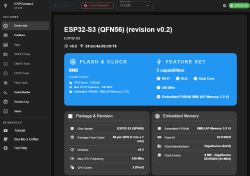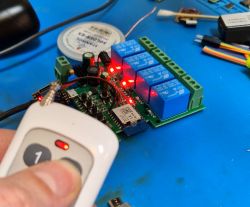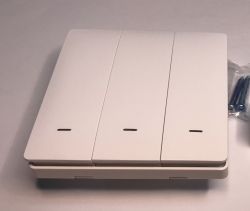Here's details and pinouts for the EARU model EAKCB-EWE-M circuit breaker, purchased from AliExpress in Jun 2025:
https://www.aliexpress.com/item/1005006189189642.html
![[BL602] BL602 PTBLU-W WiFi Module Pinout and Specs in EARU EAKCB-EWE-M Circuit Breaker [BL602] BL602 PTBLU-W WiFi Module Pinout and Specs in EARU EAKCB-EWE-M Circuit Breaker](https://obrazki.elektroda.pl/5083588700_1751735837_thumb.jpg)
There's 6 rivets holding the case; you can just drill them out and then the case opens easily. The circuit breaker is rated up to 63A; the relay is marked at 60A maximum.
![[BL602] BL602 PTBLU-W WiFi Module Pinout and Specs in EARU EAKCB-EWE-M Circuit Breaker [BL602] BL602 PTBLU-W WiFi Module Pinout and Specs in EARU EAKCB-EWE-M Circuit Breaker](https://obrazki.elektroda.pl/6784444800_1751736015_thumb.jpg)
The rest of the construction looks very solid and easily capable of handling 60 amps.
![[BL602] BL602 PTBLU-W WiFi Module Pinout and Specs in EARU EAKCB-EWE-M Circuit Breaker [BL602] BL602 PTBLU-W WiFi Module Pinout and Specs in EARU EAKCB-EWE-M Circuit Breaker](https://obrazki.elektroda.pl/5632757700_1752179694_thumb.jpg)
Apparently these devices previously used a PSF-B wifi module. This one has a wifi module PTBLU-W based on the BL602. The module is mounted on a circuit board labelled YK-DPN-T-V1-1 which is dated 2023-6-6. I could not find any specs on the internet for the wifi module.
![[BL602] BL602 PTBLU-W WiFi Module Pinout and Specs in EARU EAKCB-EWE-M Circuit Breaker [BL602] BL602 PTBLU-W WiFi Module Pinout and Specs in EARU EAKCB-EWE-M Circuit Breaker](https://obrazki.elektroda.pl/5234194000_1751736382_thumb.jpg)
The power supply has no transformer, so the module should never be powered by mains voltage while testing and measuring signals and voltages on the circuit board.
The EAKCB-EWE-M provides a BL0942 chip for energy monitoring. Here's pictures of the other chips on the back side of the main circuit board. You can read the markings for just about every chip in one photo or the other.
![[BL602] BL602 PTBLU-W WiFi Module Pinout and Specs in EARU EAKCB-EWE-M Circuit Breaker [BL602] BL602 PTBLU-W WiFi Module Pinout and Specs in EARU EAKCB-EWE-M Circuit Breaker](https://obrazki.elektroda.pl/5895900400_1751736849_thumb.jpg)
![[BL602] BL602 PTBLU-W WiFi Module Pinout and Specs in EARU EAKCB-EWE-M Circuit Breaker [BL602] BL602 PTBLU-W WiFi Module Pinout and Specs in EARU EAKCB-EWE-M Circuit Breaker](https://obrazki.elektroda.pl/4442595900_1751736856_thumb.jpg)
To inspect the PTBLU-W wifi module, you can bend one corner of the metal shield, but the only thing to see is the BL602 chip marking (but barely visible). To do more investigation, it is necessary to remove the metal shield. If you don't have a hot air gun, you can (permanently) remove the metal shielding with a pair of pliers.
![[BL602] BL602 PTBLU-W WiFi Module Pinout and Specs in EARU EAKCB-EWE-M Circuit Breaker [BL602] BL602 PTBLU-W WiFi Module Pinout and Specs in EARU EAKCB-EWE-M Circuit Breaker](https://obrazki.elektroda.pl/5756583900_1751736626_thumb.jpg)
With some work, it was possible to trace the connection for every GPIO pin for the BL602. The photo below shows the GPIOs for the 21 pins of the wifi module. There seem to be 3 extra module pins. I don't have a hot-air tool to remove the wifi module so I wasn't able to inspect or test the backside of the module.
![[BL602] BL602 PTBLU-W WiFi Module Pinout and Specs in EARU EAKCB-EWE-M Circuit Breaker [BL602] BL602 PTBLU-W WiFi Module Pinout and Specs in EARU EAKCB-EWE-M Circuit Breaker](https://obrazki.elektroda.pl/4310332400_1751737169_thumb.jpg)
The main circuit board only uses 10 of the wifi module pins 5, 11, 12, 13, 14, 15, 16, 19, 20, 21. These are enough to control all the functions of the EAKCB-EWE-M, plus one extra pin that I don't know the function (pin 5 - GPIO 22). The wifi pin mapping is:
Pin 14 = 3V3
Pin 13 = Gnd
Pin 19 = Red LED, relay On/Off (active low) = GPIO 1
Pin 20 = Blue LED, wifi status (active low) = GPIO 5
Pin 21 = Push button switch (On/Off, active low ) = GPIO 4
Pin 11, 12 = Bi-stable relay control = GPIO 20 (Set pulse) and GPIO 21 (Reset pulse)
Pin 15, 16 = UART TX/RX connecting to BL0942 energy monitoring (GPIO 16, GPIO 7)
Pin 5 = ??? 200K ohm resistor to 3V3 ??? (GPIO 22)
There's an forum posting on how to configure the bi-stable relay in OpenBK; you may have to search further to get all the details for using BridgeFWD and BridgeREV.
https://github.com/openshwprojects/OpenBK7231T_App/issues/667
Note that you need to browse to 192.168.169.1 to access the starting OpenBK web page when the BL602 is in AP mode (with other chips, the starting web page is 192.168.4.1).
There's another posting about issues with OpenBK releases >=1.18.95 for the BL602 when activating the UART too soon after booting; a 10 second delay is recommended in the posting. https://www.elektroda.com/rtvforum/topic4127126.html
Please add to that last posting if you find other devices using the PTBLU-W wifi module, or find a simpler solution to activating the UART on a BL602.
MANY THANKS to everyone for their super-quick replies and support for this newbie!
https://www.aliexpress.com/item/1005006189189642.html
![[BL602] BL602 PTBLU-W WiFi Module Pinout and Specs in EARU EAKCB-EWE-M Circuit Breaker [BL602] BL602 PTBLU-W WiFi Module Pinout and Specs in EARU EAKCB-EWE-M Circuit Breaker](https://obrazki.elektroda.pl/5083588700_1751735837_thumb.jpg)
There's 6 rivets holding the case; you can just drill them out and then the case opens easily. The circuit breaker is rated up to 63A; the relay is marked at 60A maximum.
![[BL602] BL602 PTBLU-W WiFi Module Pinout and Specs in EARU EAKCB-EWE-M Circuit Breaker [BL602] BL602 PTBLU-W WiFi Module Pinout and Specs in EARU EAKCB-EWE-M Circuit Breaker](https://obrazki.elektroda.pl/6784444800_1751736015_thumb.jpg)
The rest of the construction looks very solid and easily capable of handling 60 amps.
![[BL602] BL602 PTBLU-W WiFi Module Pinout and Specs in EARU EAKCB-EWE-M Circuit Breaker [BL602] BL602 PTBLU-W WiFi Module Pinout and Specs in EARU EAKCB-EWE-M Circuit Breaker](https://obrazki.elektroda.pl/5632757700_1752179694_thumb.jpg)
Apparently these devices previously used a PSF-B wifi module. This one has a wifi module PTBLU-W based on the BL602. The module is mounted on a circuit board labelled YK-DPN-T-V1-1 which is dated 2023-6-6. I could not find any specs on the internet for the wifi module.
![[BL602] BL602 PTBLU-W WiFi Module Pinout and Specs in EARU EAKCB-EWE-M Circuit Breaker [BL602] BL602 PTBLU-W WiFi Module Pinout and Specs in EARU EAKCB-EWE-M Circuit Breaker](https://obrazki.elektroda.pl/5234194000_1751736382_thumb.jpg)
The power supply has no transformer, so the module should never be powered by mains voltage while testing and measuring signals and voltages on the circuit board.
The EAKCB-EWE-M provides a BL0942 chip for energy monitoring. Here's pictures of the other chips on the back side of the main circuit board. You can read the markings for just about every chip in one photo or the other.
![[BL602] BL602 PTBLU-W WiFi Module Pinout and Specs in EARU EAKCB-EWE-M Circuit Breaker [BL602] BL602 PTBLU-W WiFi Module Pinout and Specs in EARU EAKCB-EWE-M Circuit Breaker](https://obrazki.elektroda.pl/5895900400_1751736849_thumb.jpg)
![[BL602] BL602 PTBLU-W WiFi Module Pinout and Specs in EARU EAKCB-EWE-M Circuit Breaker [BL602] BL602 PTBLU-W WiFi Module Pinout and Specs in EARU EAKCB-EWE-M Circuit Breaker](https://obrazki.elektroda.pl/4442595900_1751736856_thumb.jpg)
To inspect the PTBLU-W wifi module, you can bend one corner of the metal shield, but the only thing to see is the BL602 chip marking (but barely visible). To do more investigation, it is necessary to remove the metal shield. If you don't have a hot air gun, you can (permanently) remove the metal shielding with a pair of pliers.
![[BL602] BL602 PTBLU-W WiFi Module Pinout and Specs in EARU EAKCB-EWE-M Circuit Breaker [BL602] BL602 PTBLU-W WiFi Module Pinout and Specs in EARU EAKCB-EWE-M Circuit Breaker](https://obrazki.elektroda.pl/5756583900_1751736626_thumb.jpg)
With some work, it was possible to trace the connection for every GPIO pin for the BL602. The photo below shows the GPIOs for the 21 pins of the wifi module. There seem to be 3 extra module pins. I don't have a hot-air tool to remove the wifi module so I wasn't able to inspect or test the backside of the module.
![[BL602] BL602 PTBLU-W WiFi Module Pinout and Specs in EARU EAKCB-EWE-M Circuit Breaker [BL602] BL602 PTBLU-W WiFi Module Pinout and Specs in EARU EAKCB-EWE-M Circuit Breaker](https://obrazki.elektroda.pl/4310332400_1751737169_thumb.jpg)
The main circuit board only uses 10 of the wifi module pins 5, 11, 12, 13, 14, 15, 16, 19, 20, 21. These are enough to control all the functions of the EAKCB-EWE-M, plus one extra pin that I don't know the function (pin 5 - GPIO 22). The wifi pin mapping is:
Pin 14 = 3V3
Pin 13 = Gnd
Pin 19 = Red LED, relay On/Off (active low) = GPIO 1
Pin 20 = Blue LED, wifi status (active low) = GPIO 5
Pin 21 = Push button switch (On/Off, active low ) = GPIO 4
Pin 11, 12 = Bi-stable relay control = GPIO 20 (Set pulse) and GPIO 21 (Reset pulse)
Pin 15, 16 = UART TX/RX connecting to BL0942 energy monitoring (GPIO 16, GPIO 7)
Pin 5 = ??? 200K ohm resistor to 3V3 ??? (GPIO 22)
There's an forum posting on how to configure the bi-stable relay in OpenBK; you may have to search further to get all the details for using BridgeFWD and BridgeREV.
https://github.com/openshwprojects/OpenBK7231T_App/issues/667
Note that you need to browse to 192.168.169.1 to access the starting OpenBK web page when the BL602 is in AP mode (with other chips, the starting web page is 192.168.4.1).
There's another posting about issues with OpenBK releases >=1.18.95 for the BL602 when activating the UART too soon after booting; a 10 second delay is recommended in the posting. https://www.elektroda.com/rtvforum/topic4127126.html
Please add to that last posting if you find other devices using the PTBLU-W wifi module, or find a simpler solution to activating the UART on a BL602.
MANY THANKS to everyone for their super-quick replies and support for this newbie!
Cool? Ranking DIY








![[BL602] BL602 PTBLU-W WiFi Module Pinout and Specs in EARU EAKCB-EWE-M Circuit Breaker [BL602] BL602 PTBLU-W WiFi Module Pinout and Specs in EARU EAKCB-EWE-M Circuit Breaker](https://obrazki.elektroda.pl/2432404000_1751752341_thumb.jpg)
![[BL602] BL602 PTBLU-W WiFi Module Pinout and Specs in EARU EAKCB-EWE-M Circuit Breaker [BL602] BL602 PTBLU-W WiFi Module Pinout and Specs in EARU EAKCB-EWE-M Circuit Breaker](https://obrazki.elektroda.pl/9549255000_1751752349_thumb.jpg)